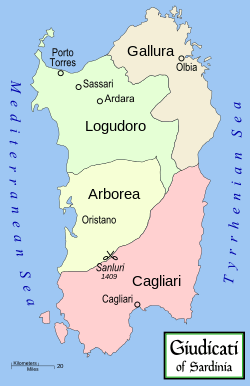Giudicato of Logudoro
| Giudicato of Torres Logu de Torres | |||||||||||||||
|---|---|---|---|---|---|---|---|---|---|---|---|---|---|---|---|
| 10th century–1259 | |||||||||||||||
 Coat of arms
| |||||||||||||||
 Giudicato di Torres (light green in the map) | |||||||||||||||
| Capital | Ardara, Porto Torres, Sassari | ||||||||||||||
| Common languages | Sardinian, Sassarese, Latin | ||||||||||||||
| Religion | Roman Catholic | ||||||||||||||
| Government | Giudicato | ||||||||||||||
| Giudicato | |||||||||||||||
• 1060 - 1073 | Barisone I of Torres | ||||||||||||||
• 1218-1233 | Marianus II of Torres | ||||||||||||||
• 1236-1259 | Adelasia of Torres | ||||||||||||||
| History | |||||||||||||||
• Established | 10th century | ||||||||||||||
• Disestablished | 1259 | ||||||||||||||
| |||||||||||||||
The Giudicato of Logudoro, also known as the Giudicato of Torres (Italian: Giudicato di Torres, Sardinian: Judicadu de Torres), after Torres, the ancient name of Porto Torres, was a state that covered the northwest portion of Sardinia from the tenth through the thirteenth century. Logudoro was one of four giudicati into which the island was divided during the High Middle Ages. The others were Gallura to the east, Arborea to the south, and Cagliari to the southeast.
Logudoro was the largest (and earliest known) of the iudicati but also the second to be swallowed up by a foreign power. It was divided into 20 curatoriae, ruled by curatores.
History
In the ninth century, the Arabs and Imazighen followed aggressive policies of expansion and piracy in the Mediterranean. The conquest of Sicily by these groups in 827 effectively cut Sardinia off from the central government and military might of the Byzantine Empire. In the absence of instruction or reinforcement, the Sardinian provincial Byzantine officials, called iudici ("judges") began to govern autonomously. By the tenth century the island was divided into four of these provinces (giudicati, literally, "judgeships"), though two — Logudoro and Arborea — were combined at the start of the eleventh century. By 900, these districts had become de facto independent states, their ruling princes still titled as iudices or judikes ("judges"') after their imperial civil servant predecessors. The first capital city for the Giudicato of Logudoro was ancient Torres (now Porto Torres), but it was exposed to Arab attacks, and so the seat of the judgeship was transferred first to Ardara, and finally to Sassari.
Logudoro only began to emerge from the fog of history during the reign of Barisone I from about 1038 to 1073. He brought Western monasticism to the island by requesting monks from Abbot Desiderius of Montecassino and in this he was supported by both Pope Alexander II and Godfrey the Bearded, Margrave of Tuscany, though the archdiocese of Pisa, thitherto chief religious influence on the island, opposed it. The monks had spiritual, scholastic and military roles. On the death of Barisone I, Arborea chose its own judge in Marianus de Zori, while the Logudorese chose Andrew Tanca.
The giudicato of Logudoro came to an end in 1259, when the giudicessa Adelasia died without an heir. After this, Logudoro was effectively ruled by the Genoese families of Doria and Malaspina, and the ruling family of Arborea. Sassari meanwhile became an autonomous city-state.[1]
See also
Notes
- ↑ Casula.
References
- Casula, Francesco (1989). The History of Sardinia. Sardinia Tourist Board.